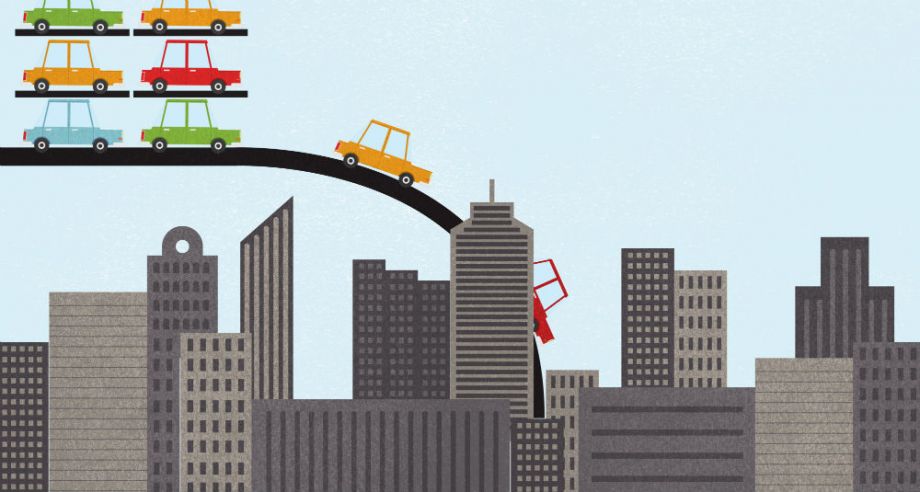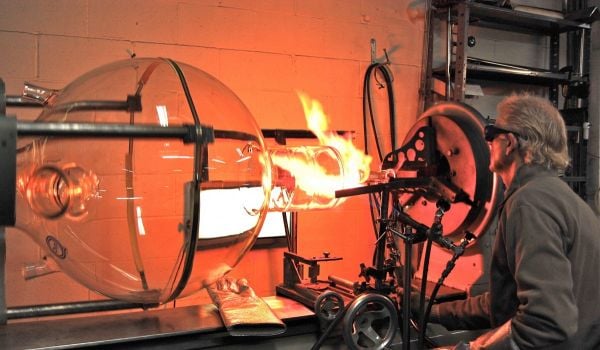In Forefront this week, Jonathan Geeting explores driverless cars and what could happen for transit, cycling and walkability when warm-blooded Americans no longer have an obligation to take the wheel.
Before the driverless car, there was the carpool. A 20th-century mechanism for car sharing, carpooling was a way for children, coworkers and those without ready access to a vehicle to nod off in the back seat while someone else drove. Maybe it was a friend’s mom. Maybe it was the guy in the cubicle next to you. No matter. What was important was you got where you needed to go and shared the bill on the ride.
Now Google driverless car and countless fantastical imaginings are popping up, many of them spawned from the corporate brain of the search engine wunderkind itself. Once you get past the magazine-ready photos of antenna-topped Priuses, there are Jetsons-esque drawings of bubble cars gliding down narrow future highways and illustrations of dense urban grids dotted with steering wheel-free taxis and zero parked cars.
Human Transit author Jarrett Walker refers to this as the “complete imagined future,” a place so far removed from lived experience that the scenarios residing there often fail to tell a plausible story about how they transcended political and economic constraints. Yet the story of driverless cars is anything but implausible. In the three years since Google cars were first spotted along Silicon Valley’s Highway 1, the technology has become one of the world’s most anticipated consumer products. The driverless, or more accurately, self-driving car is widely predicted to revolutionize mobility by knocking humans out of the driver’s seat as soon as 2030. The technology offers the possibility of infinitely safer travel. Human error — a mistimed turn, a heavy foot on the gas pedal or any one of countless other driver mishaps — caused or contributed to more than 90 percent of car collisions, according to a landmark study done by Indiana University. With automated acceleration, braking technologies and crash-avoidance technology, driverless cars could make highways exponentially less deadly.
Yet there is another opportunity at stake: The chance to dramatically reshape the relationship between public space and the car. For the last 100 years, urban planners have designed cities to accommodate personal vehicles. Every home comes with a driveway or curb for your car. Asphalt seas of parking spaces or costly multistory garages surround schools, shops and office buildings like carbon-spewing moats. What if instead of driving our own cars, we relied on 21st-century carpools — sharable autonomous vehicles?
Recent studies suggest that car use is on the wane in the U.S., with or without driverless vehicles. One study by Michael Sivak at the University of Michigan’s Transportation Research Institute found that driving rates for passenger vehicles have been on a downward slope since 2004. Other studies by the U.S. Public Interest Research Group have confirmed this, with evidence that young people are mainly responsible and that barely any statistical relationship exists between reduced driving and high unemployment rates. While the automobile industry has been quick to blame car use decline on the recession and high gas prices, available evidence suggests that economic hardship is not behind the trend.
Sivak’s hypothesis is that we are witnessing a larger structural change driven by factors like “increased telecommuting, increased use of public transportation, increased urbanization of the population, and changes in the age composition of drivers.” Indeed, the average American car sits unused 23 out of 24 hours a day. Is there any other contemporary technology we spend so much money not to use?
Last August, Google invested $258 million in Uber, an app-based ride service company that allows people to order black cars online, pay for them using their smart phones, and track their arrival. It was Google’s largest-ever venture capital investment. As the company continues to develop the technology to pilot drone taxis, it also, presumably, wants to popularize the interface for hailing them, and develop the algorithms for dispatching the fleet. With automated vehicles in the picture, services like Uber, already quickly growing in popularity, could become significantly less expensive and thus accessible to more people. Already, researchers at Columbia University’s Earth Institute have estimated that a fleet of shared autonomous vehicles, providing the same level of service as New York’s yellow taxicab fleet, could slash the cost from $4 per trip mile down to 50 cents per trip mile — an eightfold cost reduction.
There is much to recommend in this imagined world of cheap, ubiquitous drone taxis. This is a world where senior citizens, the disabled, young people and the inebriated can enjoy safer mobility and be freed from the enormous costs of owning and insuring a car. It’s also a world wherein parked cars have a smaller footprint. In 2010, researchers at the University of California, Berkley released a study on the country’s parking infrastructure. While conceding that assessments of the number of parking paces have varied significantly, they cited a series of estimates, from which we can draw a reasonable range. Following this data, current parking codes have made it so there are between three and eight parking spaces for each of the 250 million cars in America. Think about it this way: If the number of personal cars dropped and parking provisions were loosened, as many as 675 million parking spaces, particularly those in urban cores, could be turned into something else — housing, parks or a million other uses more desirable than street-deadening parking lots.
“If you could push all the land currently devoted to parking in Manhattan and Boston and other big cities 10 minutes outside the city limits,” says Anthony Townsend, author of Smart Cities, “you’re potentially talking about trillions of dollars worth of real estate that could be developed, and tens of millions of new city-dwellers who could be accommodated.”
The Eno Center for Transportation, a think tank in Washington, estimates that, at 90 percent market penetration, autonomous vehicle (AV) technology could save the country $201 billion annually and a whopping $447 billion in comprehensive benefits from savings related to reduced congestion and fewer crashes. Eno predicates its estimates on the expectation that a single shared autonomous vehicle could make five times as many trips as a non-shared vehicle. The center assumes 10 percent of AVs will be shared.
But the legal replacement of human drivers is by no means a given, as the millions of workers now in the business of transporting people and goods are unlikely to back down quietly. Indeed, whether fully autonomous vehicles are ultimately ever allowed to come to market will hinge on a high-stakes, behind-the-scenes political struggle just now getting underway.
To read more, subscribe to Forefront. Already a subscriber? Click here to continue reading.
















